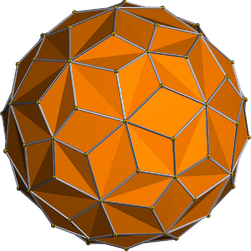Small hexagonal hexecontahedron
| Small hexagonal hexecontahedron | |
|---|---|
 | |
| Type | Star polyhedron |
| Face |  |
| Elements | F = 60, E = 180 V = 112 (χ = −8) |
| Symmetry group | Ih, [5,3], *532 |
| Index references | DU32 |
| dual polyhedron | Small snub icosicosidodecahedron |
In geometry, the small hexagonal hexecontahedron is a nonconvex isohedral polyhedron. It is the dual of the uniform small snub icosicosidodecahedron. It is partially degenerate, having coincident vertices, as its dual has coplanar triangular faces.
Geometry
Treating it as a simple non-convex solid (without intersecting surfaces), it has 180 faces (all triangles), 270 edges, and 92 vertices (twelve with degree 10, twenty with degree 12, and sixty with degree 3), giving an Euler characteristic of 92-270+180 = +2.
Construction
Disregarding self-intersecting surfaces, the small hexagonal hexecontahedron can be constructed as a Kleetope of a pentakis dodecahedron. It is therefore a second order Kleetope of the regular dodecahedron. In other words, by adding a shallow pentagonal pyramid to each face of a regular dodecahedron, we get a pentakis dodecahedron. By adding an even shallower triangular pyramid to each face of the pentakis dodecahedron, we get a small hexagonal hexecontahedron.
The 60 vertices of degree 3 correspond to the apex vertex of each triangular pyramid of the Kleetope, or to each face of the pentakis dodecahedron. The 20 vertices of degree 12 and 12 vertices of degree 10 correspond to the vertices of the pentakis dodecahedron, and also respectively to the 20 hexagons and 12 pentagons of the truncated icosahedron, the dual solid to the pentakis dodecahedron.
References
- Wenninger, Magnus (1983), Dual Models, Cambridge University Press, ISBN 978-0-521-54325-5, MR 730208